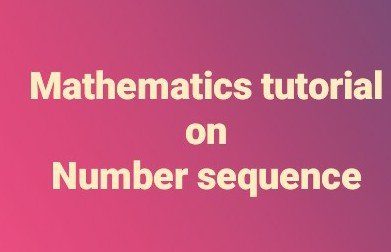Mathematics tutorial on Number Sequence.

Introduction
It's me again, Hayzeed, the mathematics and electrical courses blogger, today we are starting Number sequence.
What is Number Sequence?
Number sequence is simply a set of numbers next to each other in set order.
Number sequences can be used as a tool to practice and improve your numerical reasoning skills. These types of test are found in IQ Tests, psychometric assessments, and aptitude tests and are often being used, in combination with other tests, as an indicator for a person’s intelligence. By practicing them you can improve your numerical reasoning ability which can be of great help in daily life activities like loan calculations, groceries or during job applications in assessments.
There are two main types of number sequences which are; Arithmetic progression and Geometric progression.
We are only dealing with Arithmetic progression in this tutorial, Geometric progression will be treated in the next tutorial.
What is Arithmetic Progression?
Arithmetic Progression is a sequence with the difference between two consecutive terms constant. This difference is called Common difference, Arithmetic Progression is often abbreviated to AP.
Let's consider these examples below;
(i) 1, 4, 7, 10, 13, ... where the common
the difference is 3.
How did we arrived at 3??
It is easy , subtract the second term from the first term, or subtract the third term from the second term.
Do you get that??
(ii) a, a + d, a + 2d, a + 3d, ... where the
common difference is d.
If the 1st term of an AP is ‘a’, the common difference is ‘d’ and the last term is 'l' then nth term of an AP is given as Tn= a + (n − 1)d
From example (i), we can find the 7th term easily using the formula.
First term (a)= 1
Common difference (d)=3
number of term (n)=7.
The nth term formula of AP= Tn= a +(n-1)d
By substituting the values into the formula, then the 7th term= 1 + (7 - 1)3
= 1 + 6(3)= 1 +18=19.
Hence, the 7th term is 19.
Do you agree with this??*
Let's do it manually to confirm the answer.
1,4, 7, 10, 13, ............
Since the difference between the two consecutive number is 3.
First term = 1
Second term= 1 +3= 4
Third term = 4 + 3=7
Fourth term= 7 +3 =10
Fifth term = 10 + 3 =13
Sixth term = 13 +3 = 16
Seventh term= 16 +3 = 19
Yeah, we get the same answer, now, which method is faster and easier?
To be continued in the next tutorial.....
Exercises
- Determine (a) the 9th, and (b) the
16th term of the series 2, 7, 12, 17,...- The 6th term of an AP is 17 and the
13th term is 38. Determine the 19th term.- Determine the number of the term which is 29
in the series 7, 9.2, 11.4, 13.6, ...
References
Engineering mathematics by John Bird
Hi @hayzeed. I followed you as I might need your help in the future as I am a math teacher also.
No problem.. I have followed you also.
Thanks😊
Congratulations! This post has been upvoted from the communal account, @minnowsupport, by Hayzeed from the Minnow Support Project. It's a witness project run by aggroed, ausbitbank, teamsteem, theprophet0, someguy123, neoxian, followbtcnews, and netuoso. The goal is to help Steemit grow by supporting Minnows. Please find us at the Peace, Abundance, and Liberty Network (PALnet) Discord Channel. It's a completely public and open space to all members of the Steemit community who voluntarily choose to be there.
If you would like to delegate to the Minnow Support Project you can do so by clicking on the following links: 50SP, 100SP, 250SP, 500SP, 1000SP, 5000SP.
Be sure to leave at least 50SP undelegated on your account.